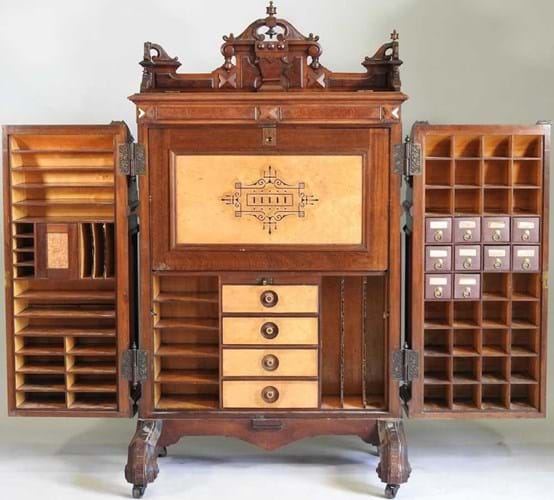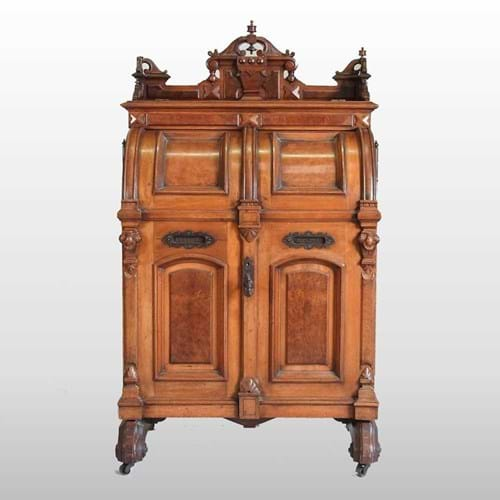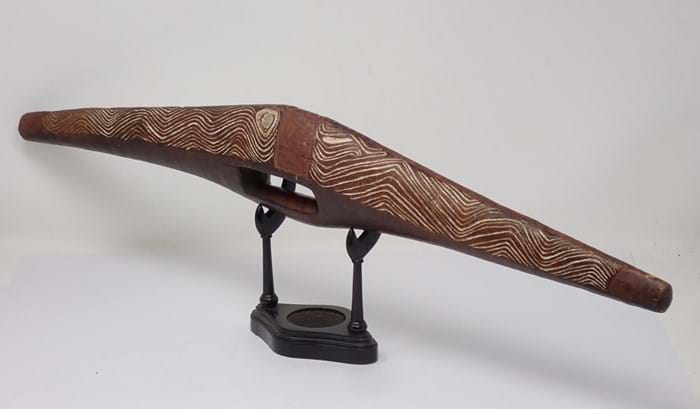1. Wooton secretaire desk – £6000
The latest sale at Mander Auctions in Sudbury was topped by this textbook example of late 19th century American furniture, the Wooton secretaire desk.
William S. Wooton was an Indianapolis entrepreneur (and later Protestant preacher) who obtained a series of patents for office furniture design in the 1870s. He employed mass production methods, while creating the product in four different grades, three different sizes and a number of different styles.
The first Wooton desks, like those shown to great acclaim at the 1876 Philadelphia Centennial Exhibition, were made in the popular Renaissance revival style but later examples embraced the Aesthetic movement. Advertised as ‘The King of Desks’ they were expensive (priced at between $90-750 each) but sold well at a time when the filing cabinet was becoming the essential office accessory.
Production of Wooton desks continued until about 1884 and thereafter the model was produced by a series of firms in the Midwest. However, it is those from the original decade that are the most sought after.
This example, in walnut with a maple interior is fully inscribed 'Manufactured by The Wooton Desk Co, Indianapolis, Ind, Pat Oct 1874’. Estimated at £2000-3000 at the sale in Suffolk on August 19, it took £6000 from a buyer using thesaleoom.com.
2. ‘Churchill’ hip flask – £2300
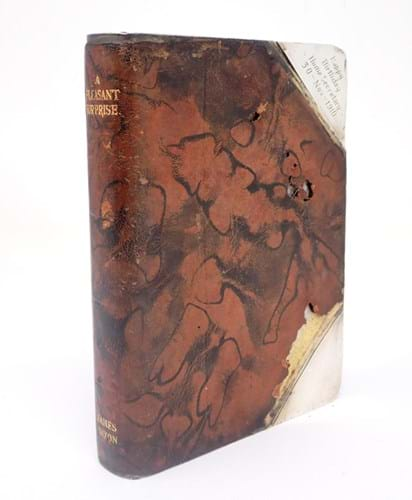
Novelty James Dixon hip flask with the dedication Happy Birthday Home Secretary 30th Nov 1910 – £2300 at Minster Auctions.
The series of novelty ‘book’ hip flasks made by James Dixon & Co of Sheffield c.1900-10 are always popular collectables.
Made in silverplate and leather and given titles such as Spirit of the Ages, Paradise Regained or The Traveller's Friend, they open via a secret gilt bayonet detachable corner cap. Typically they bring £100-200 at auction.
However, the example offered at Minster Auctions in Leominster on August 18 was potentially a bit special. To the top right corner, it is inscribed with the dedication Happy Birthday Home Secretary 30th Nov 1910. It is thus believed to have been a gift to Winston Churchill in his first year as Home Secretary in the Asquith government.
For this reason (and despite its far from perfect condition) it was given a guide of £1900-2200 and in fact tipped over the top estimate to bring £2300 from an online bidder.
3. Portrait by Maurice Denton Welch – £8000
This portrait by the English writer and painter Maurice Denton Welch (1915-48) sold for a surprise £8000 to an online bidder at Rogers Jones in Cardiff. Estimated at £500-600, it was part of a timed auction that closed on August 21.
Denton Welch is thought to have painted the picture 'Girl in Yellow Sweater', around the age of 20 while a student at Goldsmiths in London. He had spent his early childhood years in Shanghai, the son of a wealthy English rubber merchant, and returned to China after unhappy schooling at Repton. At the age of 20, Welch was hit by a car while cycling in Surrey and suffered the injuries that ultimately led to his early death.
According to labels to the 2ft 1in x 161/4in (64 x 41cm) picture the subject was thought to be Evelyn Sinclair, his friend and housekeeper with whom he shared an apartment close to his doctor in Tonbridge. However, the label goes on to say that this theory was rejected by Denton Welch’s long-term partner, Eric Oliver, who believed the sitter was a fellow student at Goldsmiths.
The picture came from a private collection in Monmouthshire in fair condition: the paint surface was cracked with some poor-quality restoration to paint losses in the hair and left arm.
4. Aboriginal parrying shield – £7500
Aboriginal shields come in two basic types – broad shields used for deflecting projectiles and the narrow, compact parrying shields used in close contact fighting. This 2ft 4in (70cm) example of the wedge-shaped parrying shield or malcarra was offered for sale at Minster Auctions in Leominster on August 18. It has patterns cut with an animal tooth highlighted in white pipe clay, typical of shields from the Darling River or Murrumbidgee River region of New South Wales.
It is probably early to mid 19th century in date: by 1850 most of south-eastern Australia was under European control and nearly all of the Aboriginal groups had been displaced.
Estimated at £2000-3000, it took £7500 from an online bidder.
5. Irish damask tablecloth and napkins – £1600
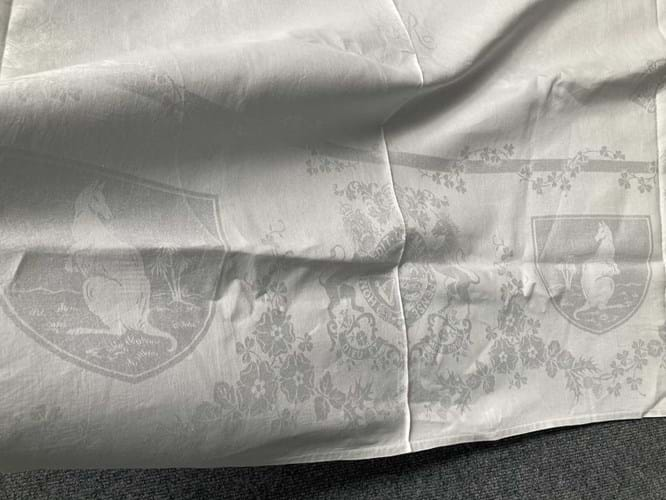
Detail of an Irish damask tablecloth and napkins made around the time of the coronation of George V – £1600 at Tennants.
The sale of Costume, Accessories & Textiles at Tennants in Leyburn on August 20 included an unusual example of early 20th century Irish linen – a white damask tablecloth and napkins made around the time of the coronation of George V in 1910. Woven with the words 'Irish Linen Hand Woven Damask' to the edge, the various vignettes included a portrait of George V, the Union flag, the Royal Coat of Arms plus various symbols of the British empire – elephants, kangaroos, a platypus, a kiwi and an emu.
It is thought that these linens (other examples have been offered for sale in the past) were specifically made for the Royal Household c.1911. In overall in good condition, it took £1600 (estimate £400-600) selling via thesaleroom.com.

